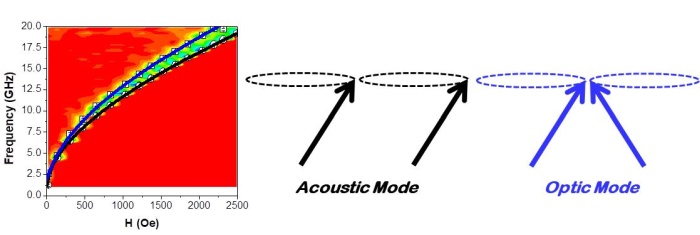Speaker
Description
Nowadays, we are immersed in a digital society where information is continually transferred between different devices, forcing us to look for new alternatives that allow the faster transfer of information with the lowest possible energy consumption. Magnetic thin films have been successfully used but their related natural resonance frequency is restricted to the range of a few GHz, and it should be increased to allow for current technological needs [1]. In 2016, Li et al. [2] proved that coupled ferromagnetic bilayers can present higher ferromagnetic resonances, the acoustic and optic modes, as compared to single thin films.
Here, the static and dynamic magnetic responses of symmetric and asymmetric multilayer bimagnetic systems of different non-magnetic spacer thickness have been studied. The symmetric system is composed of Fe(10nm)/Al (0-2nm)/Fe(10nm), and the antisymmetric one of Co(10nm)/Cu(0-8nm)/CoFeB(10nm) [3]. We have observed both the acoustic and optic modes and it is demonstrated that the resonance frequency of the optic mode is very sensitive to the interlayer coupling constant that depends on the geometrical and compositional nature of layers. Particularly, high resonance frequencies can be achieved (over 25 GHz) for Co/CoFeB bilayers with interlayer exchange coupling $J_{eff}$ = (2.7 $\pm$ 0.8) erg/cm$^2$.

Fig. 1 VNA-FMR spectra of Co(10nm)/Cu(3nm)/CoFeB(10nm) trilayer where black and blue lines correspond to the acoustic and optic modes, respectively. Diagrams of both modes.
Acknowledgements
Authors acknowledge financial support from Projects CNS2022-135949 and PID2022-137567NB-C21 by the Spanish Ministry of Science and Innovation, Project FONDECYT/REGULAR 1201102 by ANID, and Projects UIDP/04968/2020 and 2022.03564.PTDC by FCT.
References
[1] K. David and H. Berndt, “6G Vision and Requirements: Is There Any Need for Beyond 5G?,” IEEE Vehicular Technology Magazine, vol. 13, no. 3. Institute of Electrical and Electronics Engineers (IEEE), pp. 72–80, Sep. 2018. doi: 10.1109/mvt.2018.2848498.
[2] S. Li et al., “Tunable Optical Mode Ferromagnetic Resonance in FeCoB/Ru/FeCoB Synthetic Antiferromagnetic Trilayers under Uniaxial Magnetic Anisotropy,” Advanced Functional Materials, vol. 26, no. 21. Wiley, pp. 3738–3744, Apr. 13, 2016. doi: 10.1002/adfm.201600122.
[3] Z. Wei et al., “Static and dynamical behaviour of magnetically coupled Co/Cu/CoFeB trilayers,” Journal of Magnetism and Magnetic Materials, vol. 589. Elsevier BV, p. 171584, Jan. 2024. doi: 10.1016/j.jmmm.2023.171584.

